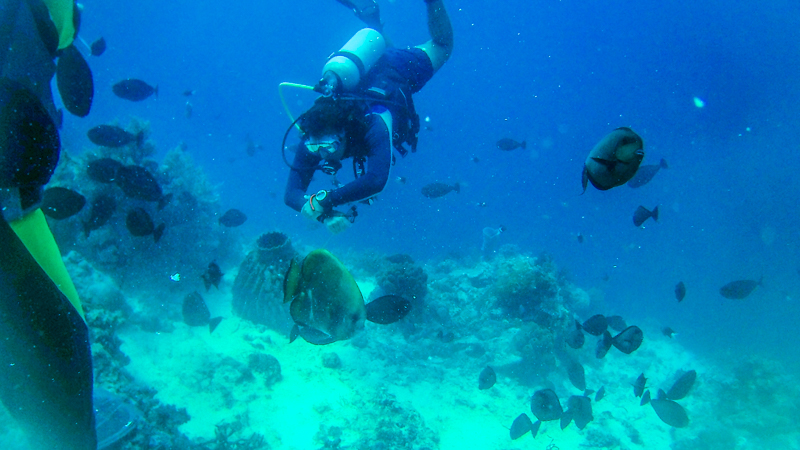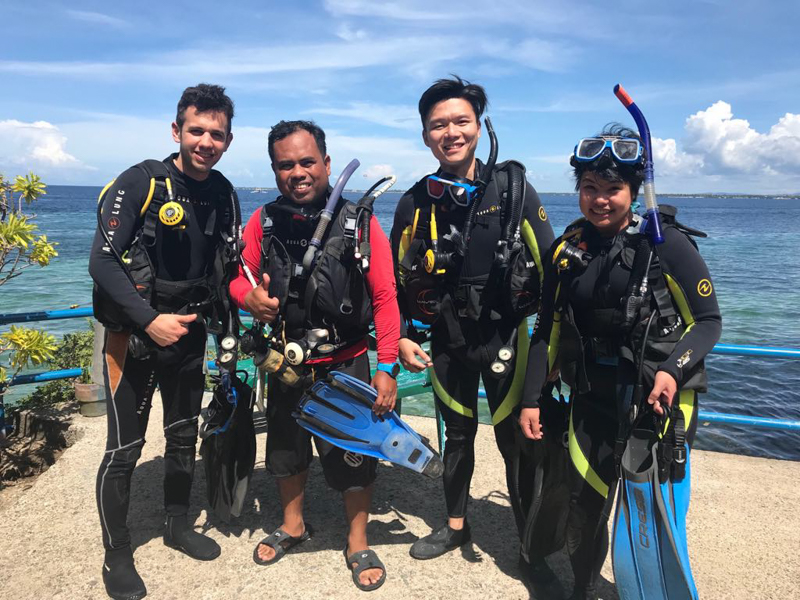Learning How to Scuba Dive in the Philippines

Scuba diving had been an item on my bucket list since I had gone to the Bahamas and tried to Snuba. My love for being underwater was a total surprise since I grew up hating the smell of chlorine. But there’s something majestic about floating underneath the water’s surface and interacting with a lesser known part of the earth.
Prior to my trip, I had considered taking the introductory PADI course at a dive shop in Chicago, but dealing with travel logistics to get to the nearest quarry and timing the course with the weather and my work schedule didn’t seem too appealing.
Then in January, while eating dinner with a friend, we randomly sat next to a woman from Florida who was in town for a work conference. She also happened to be an avid diver and talked about how much cheaper it was to dive outside of the U.S. (she had done her training in Honduras ten years ago). Since the Philippines is also known for diving and I would be spending a good chunk of time there, I looked into taking an Open Water PADI course in Cebu/Mactan.


For anyone interested in diving, it is absolutely worth going to the Philippines to get Open Water certified. The price of learning in Chicago would have been $499 plus the cost of equipment rentals. The price to learn with SiDive in the Philippines was $270, and that included all gear rentals and accommodations. Aaaaaand I don’t think I have to go into the differences between diving in the U.S. Midwest and in the tropics of the Philippines.
PADI Open Water Course

There are two different courses you can take as a beginner diver—the Scuba Diver course allows you to dive up to 12m with a PADI divemaster or instructor, and the Open Water course allows you to dive up to 20m with another certified diver. I opted to take the latter and contacted Simon from SiDive through the PADI website.
Both courses contain a classroom theory component and a confined/open water component. You can do the theory on your own time. If you contact Simon directly, he can hook you up with an online module, which takes about 12-16 hours to complete, or you can come a day early and do all the theory at his house. Then you show up for diving lessons, which takes two days and includes four open water dives!
SiDive
SiDive is run by Simon, a laid back dude from the UK. Once you schedule your course dates with him, he’ll set you up with accommodations, either at his place or at a nearby hostel. He also provides transportation to and from the dive shop.


I was in a class with three other travelers. Our two awesome dive instructors, Alfred and Jake, were extremely fun and made learning a breeze.
On Day 1, we focused on learning some basic skills (like clearing your mask underwater which is THE WORST). We also practiced what to do if you or your dive partner run out of air, and how to get in and out of your BCD while underwater. Then we did two shore dives and called it a day.





On Day 2, we finished learning skills and then rented a boat to do our final dives at a wreck site (we got to swim through an airplane wreck!) and a sanctuary.






While diving Mactan/Lapu Lapu isn’t necessarily known for its dive sites, there are still a few cool things to see, especially for first time divers. Simon and his team were great teachers, and I highly recommend any beginning diver to do their Open Water courses with SiDive.


Epilogue
Once you receive your Open Water certification, you’re able to dive at any site up to 20m. Just contact a dive shop and they’ll set you up with a dive buddy. I did another dive in Apo Island a week later, which only cost PHP2800 for two dives (that’s about $50 USD), including all the gear.
You can also choose to take additional courses focused on special skills like underwater photography or underwater naturalist or wreck diving, or you can continue the progression of courses and take Advanced Open Water and Rescue Diving, which I’m 80% sure I’m going to do in Thailand.
I’ve met a few people who’ve earned their divemaster and dive instructor certifications interning at dive shops across the Philippines and now make their living diving around the world. I’m not gonna lie, it seems like a pretty cool gig…